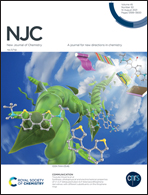Structure–property relationship of novel supramolecular gels based on coumarins†
Abstract
In this article, the gelation potential of three coumarin derivatives in a variety of solvents was studied. We have found that, of these three compounds, ethyl 7-hydroxy-2-oxo-2H-chromene-3-carboxylate (2a) and ethyl 7-methoxy-2-oxo-2H-chromene-3-carboxylate (3a) were able to form gels in the same solvents (cyclohexanol, octanol, and DMSO/water), while ethyl 2-oxo-2H-chromene-3-carboxylate (1a) only formed in one, thus observing the influence of the substitute in position seven. One of them (2a) has unusual mechanical properties since it can be subjected to compressive forces and return to its initial state, something rare to observe in this type of material. In addition, during the formation of one of the gels, an additional process was observed during the sol–gel transition which is interrupted by a third stage in which a precipitate is formed, this precipitate requires a rearrangement to subsequently obtain the corresponding gel. The characterization of the gels by SEM revealed fibrillar structures in one of the compounds (2a) while in the other crystals they showed 2D structures. On the other hand, the use of different spectroscopic and computational techniques demonstrated the importance of hydrogen bond formation and π–π stacking for the formation of the internal structure of the gel.



 Please wait while we load your content...
Please wait while we load your content...